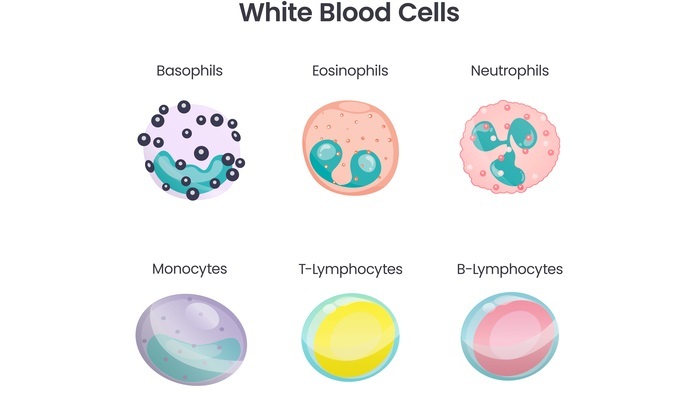
 Data Structure
Data Structure Networking
Networking RDBMS
RDBMS Operating System
Operating System Java
Java MS Excel
MS Excel iOS
iOS HTML
HTML CSS
CSS Android
Android Python
Python C Programming
C Programming C++
C++ C#
C# MongoDB
MongoDB MySQL
MySQL Javascript
Javascript PHP
PHP
- Selected Reading
- UPSC IAS Exams Notes
- Developer's Best Practices
- Questions and Answers
- Effective Resume Writing
- HR Interview Questions
- Computer Glossary
- Who is Who
Myelocyte - A Cell of Granulocytic Series
Introduction
Blood is a vital component of the human body, transporting oxygen and nutrients throughout the body and removing waste products. It is a complex mixture of different types of cells and plasma, which work together to maintain homeostasis.
White blood cells, also known as leukocytes, play a crucial role in the body's immune system. They help defend the body against infections and other foreign invaders.

One of the types of leukocytes is the myelocyte. It is a cell of the granulocytic series and is one of the stages of the maturation of neutrophils. Myelocytes are a critical part of the body's immune system and play a crucial role in fighting infections.
Structure of Myelocytes
Myelocytes are a type of white blood cells that belongs to the granulocytic series. They are found in the bone marrow, where they differentiate into different types of granulocytes.
Myelocytes have a round or slightly oval nucleus and are typically larger than other types of white blood cells. They contain a large number of granules in their cytoplasm, which are responsible for their function.
Function of Myelocytes
Myelocytes play a critical role in the body's immune system. They are responsible for the production of granulocytes, which are a type of white blood cell that helps fight infections.
Granulocytes are classified into three types: neutrophils, eosinophils, and basophils. Myelocytes differentiate into different types of granulocytes based on the specific needs of the body.
Neutrophils are the most abundant type of granulocyte and are responsible for fighting bacterial infections. When a bacterial infection occurs, the body releases chemicals that attract neutrophils to the site of infection. Neutrophils then attack the bacteria, engulfing and destroying them.
Eosinophils are responsible for fighting parasitic infections and are also involved in allergic reactions. They release enzymes that attack parasites and contribute to the inflammation associated with allergies.
Basophils are the least common type of granulocyte and are involved in allergic reactions. They release histamine, which causes blood vessels to dilate and become more permeable. This allows other immune cells to enter the affected area and fight off the foreign invader.
Myelocytes are also involved in the process of phagocytosis. Phagocytosis is the process by which cells engulf and destroy foreign invaders, such as bacteria or viruses. Myelocytes are capable of phagocytosis and can engulf and destroy bacteria and other foreign invaders.

Maturation of Myelocytes
Myelocytes are formed in the bone marrow and undergo a process of maturation before they become fully functional. The process of maturation is known as granulopoiesis and involves several different stages. These stages include ?
Myeloblasts: Myeloblasts are the earliest stage of the granulocytic series. They are large cells with a round or slightly oval nucleus and a small amount of cytoplasm.
Promyelocytes: Promyelocytes are the next stage of the granulocytic series. They are slightly larger than myeloblasts and contain a small number of granules in their cytoplasm.
Myelocytes: Myelocytes are the third stage of the granulocytic series. They are larger than promyelocytes and contain a large number of granules in their cytoplasm.
Metamyelocytes: Metamyelocytes are the fourth stage of the granulocytic series. They are slightly smaller than myelocytes and have a kidney-shaped nucleus.
Band Neutrophils: Band neutrophils are the fifth stage of the granulocytic series. They are also known as "stabs" and have a nucleus that is slightly curved or band-shaped.
Segmented Neutrophils: Segmented neutrophils are the final stage of the granulocytic series. They have a segmented nucleus, which gives them their characteristic appearance.
The maturation process takes approximately two weeks, after which the myelocytes differentiate into the specific type of granulocyte that the body needs.
Myelocyte Disorders
Myelocyte disorders can affect the body's immune system and lead to various health problems. Some of the common myelocyte disorders include ?
Myelodysplastic syndrome (MDS): MDS is a group of blood disorders that affect the production of blood cells in the bone marrow. It can lead to a decrease in the number of myelocytes and other white blood cells, which can weaken the immune system and increase the risk of infections.
Leukemia: Leukemia is a type of blood cancer that affects the production of white blood cells, including myelocytes. It can lead to an overproduction of myelocytes and other white blood cells, which can affect the body's ability to fight infections.
Neutropenia: Neutropenia is a condition in which there is a decreased number of neutrophils, which are a type of granulocyte produced by myelocytes. It can increase the risk of infections and other health problems.
Treatment for myelocyte disorders depends on the specific disorder and may include medications, chemotherapy, radiation therapy, and bone marrow transplantation.
Conclusion
Myelocytes are a critical part of the body's immune system and play a crucial role in fighting infections. They are responsible for the production of granulocytes, which are a type of white blood cell that helps defend the body against foreign invaders.
Myelocytes undergo a process of maturation before they become fully functional, and disorders affecting their production can lead to various health problems. Further research on myelocytes is needed to better understand their role in the immune system and develop effective treatments for myelocyte disorders.

